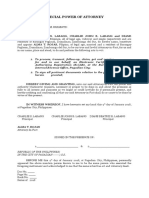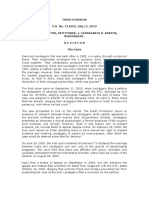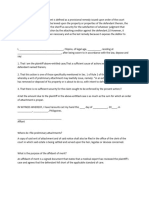Features of Parliamentary Form of General Government12
Features of Parliamentary Form of General Government12
Uploaded by
Shan KhingCopyright:
Available Formats
Features of Parliamentary Form of General Government12
Features of Parliamentary Form of General Government12
Uploaded by
Shan KhingOriginal Description:
Copyright
Available Formats
Share this document
Did you find this document useful?
Is this content inappropriate?
Copyright:
Available Formats
Features of Parliamentary Form of General Government12
Features of Parliamentary Form of General Government12
Uploaded by
Shan KhingCopyright:
Available Formats
Features of Parliamentary Form of General
Government
Parliamentary Form of Government is the system of government in which there exists
an intimate relationship between the executive and the legislative departments, and the
stability and efficacy of the executive department depend on the legislature.
Although the parliamentary government is broadly defined in the above way, in such a
system the supremacy of the legislature has now been replaced by the supremacy of
the Cabinet. Hence, such form of government is also called Cabinet Government.
This form of government exists in countries like Britain, India and Canada. The Features
of Parliamentary Form of Government has been discussed below:
Features
1. Existence of a Titular or Constitutional Ruler: The first characteristic feature of the
parliamentary system is the existence of a Titular of Constitutional Ruler. Legally the
administration of all the affairs of the state is conducted by the head of the state. In
reality, however, the administration is carried on in his name by the Council of
Ministers. He is the head of the state, but not the head of the government.
2. Absence of Separation of Powers: In the parliamentary system the principle of
separation of powers is not adopted. Here the three departments of government
work in close, intimate contact, sharing some of the powers and functions of one
another.
3. Main Role of the Lower House in Ministry-formation: In the parliamentary
government the lower house of the legislature, i.e., the popular chamber plays a vital
role in the formation of the ministry. The leader of the party or alliance which wins
the majority in this house is appointed the Prime Minister or Chancellor. The
constitutional ruler appoints the other members of the ministry on his advice.
4. Responsibility to the Legislature: In such a system the Cabinet or Ministry has to
remain responsible to the legislature for all its activities and policies. In countries having
bi-cameral legislatures, the Cabinet remains responsible to the lower house composed
of the peoples representatives.
5. Collective Responsibility: The ministerial responsibility to the legislature may again
be of two kinds:
Individual responsibility, and
Collective responsibility.
Individual responsibility means that the minister in charge of a department must be
answerable for the activities of his department. But when the ministers remain jointly or
collectively responsible to the legislature for the policies and activities of the
government, it is called collective responsibility. Since no individual minister can
unilaterally perform any business of government without the consent of the Cabinet, the
entire Ministry or Cabinet has to remain accountable for the errors of the minister
concerned.
6. Intimate relationship between the Legislature and the Executive: In the
parliamentary system an intimate relationship exists between the executive and the
legislative departments. So they can easily control each other. The leaders of the
majority party or alliance in the legislature become the members of the Cabinet or
Ministry. Naturally, the ministers can easily extend their influence on the legislature.
Consequently, the programs and policies of the Cabinet are backed by a majority inside
the legislature.
7. Leadership of the Prime Minister: The leadership of the Prime Minister is another
major feature of the parliamentary system. The leader of the majority party in the
legislature becomes the Prime Minister. Though, in theory, he is primus inter pares, i.e.
first among equals, in reality, he possesses much greater power and status than the
other ministers. As the undisputed leader of the majority party or alliance in the
legislature he plays the most vital role in the determination and execution of government
policies. Indeed, the success of parliamentary democracy depends, to a great extent, on
the personality, efficiency and charisma of the Prime Minister.
8. Existence of a Strong Opposition: The existence of one or more strong and wellorganized opposition party or parties is the hall-mark of the parliamentary system. By
criticizing the errors of the government, the opposition can compel it to adopt welfare
measures and prevent it from becoming despotic. Judged from this angle, the
opposition can be called the life-force of parliamentary democracy.
9. Cabinet Dictatorship: In the parliamentary system of government the cabinet has to
perform manifold functions. It is the Cabinet which:
formulates well-considered policies of the Government after reviewing both the
national and international issues,
takes necessary, arrangements for passing laws to implement the policies
formulated by it,
determines the matters to be included in the agenda of the central legislature,
controls and directs the administrative departments so that laws, Government
orders, etc. are to be implemented properly,
co-ordinates the activities of different departments of the Government,
prepares the draft budget in consultation with the Prime Minister and takes
necessary initiative to get it passed in the legislature,
formulates economic policies and takes necessary steps for implementing the
same,
advices the constitutional head to take necessary action during emergency or
unforeseen situation, etc.
In this way the Cabinet acts as the keystone of the political arch or has become the
steering wheel of the ship of fact of the state. In fact, in the parliamentary system of
government as the cabinet members are the leaders of the majority party or alliance in
the legislature and the head of the state is nothing but a magnificent cipher, the Cabinet
under the leadership of the Prime Minister has virtually become dictator.
You might also like
- DENR-Letter of ProtestDocument1 pageDENR-Letter of ProtestShan Khing58% (12)
- Barangay ResolutionDocument2 pagesBarangay ResolutionShan Khing88% (24)
- Institutional CorrectionDocument17 pagesInstitutional Correctioncriminologyalliance91% (11)
- Unitary and Federal Form of GovernmentDocument10 pagesUnitary and Federal Form of GovernmentGhosty Roasty100% (1)
- Characteristics of One Party SystemDocument4 pagesCharacteristics of One Party SystemKyaw Lynn100% (2)
- Presidential and Parliamentary FormDocument21 pagesPresidential and Parliamentary FormMounika KalakotiNo ratings yet
- Difference Between Presidential and Parliamentary Form of Govt PDFDocument1 pageDifference Between Presidential and Parliamentary Form of Govt PDFAna JainNo ratings yet
- Merits and Demerits of Presidential Form of GovernmentDocument12 pagesMerits and Demerits of Presidential Form of Governmentshreya8chourasia-1100% (1)
- State and Its ElementsDocument27 pagesState and Its ElementsBasit Zaman100% (2)
- State and Its ElementsDocument3 pagesState and Its ElementsMuhammad Umar Aman100% (2)
- Politicals Science - I - F.Y.B.A PDFDocument122 pagesPoliticals Science - I - F.Y.B.A PDFRaja Mohan GopalakrishnanNo ratings yet
- Legitimacy 1Document7 pagesLegitimacy 1Yash TiwariNo ratings yet
- Force TheoryDocument5 pagesForce TheoryGaurav Tripathi100% (1)
- What Are The Characteristics of A Political Party?Document10 pagesWhat Are The Characteristics of A Political Party?Alok Kumar JhaNo ratings yet
- 1) Power and Function of The ParliamentDocument51 pages1) Power and Function of The ParliamentSutithi ChakrabortyNo ratings yet
- State and Its ElementsDocument2 pagesState and Its ElementsAasish Majhi100% (1)
- Definition of State and ItDocument4 pagesDefinition of State and ItAmir MughalNo ratings yet
- THEORIES On The Origin of The StateDocument14 pagesTHEORIES On The Origin of The StateAiza San Pedro SantosNo ratings yet
- DemocracyDocument17 pagesDemocracyAanya Chauhan100% (1)
- 3 Political CultureDocument22 pages3 Political CultureElena VoinovanNo ratings yet
- Political CultureDocument5 pagesPolitical CultureDivyank SurumNo ratings yet
- House of CommonsDocument4 pagesHouse of CommonsInaam Ullah BalochNo ratings yet
- Relationship of Political Science With Other Social ScienceDocument5 pagesRelationship of Political Science With Other Social ScienceShadab AnwarNo ratings yet
- 3 Organs of Government Legislature Executive and JudiciaryDocument22 pages3 Organs of Government Legislature Executive and JudiciaryRitesh50% (2)
- Political Science: Scope. Approaches. GoalsDocument13 pagesPolitical Science: Scope. Approaches. GoalsFyna Bob100% (1)
- Approaches To The Study of Political ScienceDocument2 pagesApproaches To The Study of Political Scienceehtisham0% (1)
- Approaches - Traditional Behavioural PostbehaviouralDocument9 pagesApproaches - Traditional Behavioural PostbehaviouralLisa SajiNo ratings yet
- Theories of StateDocument24 pagesTheories of StateAmandeep Malik100% (1)
- Concepts of Political ScienceDocument25 pagesConcepts of Political SciencemusafirNo ratings yet
- Topic 2: Power, Authority & LegitimacyDocument30 pagesTopic 2: Power, Authority & LegitimacyMela Padillo100% (1)
- Meaning and Elements of StateDocument2 pagesMeaning and Elements of StateJeje NutNo ratings yet
- PP Pillar by AfnanDocument4 pagesPP Pillar by AfnanAfnan MustafaNo ratings yet
- Theories On The Origin of StateDocument3 pagesTheories On The Origin of StateВладислава ЧёрнаяNo ratings yet
- POSDCORB - Wikipedia, The Free EncyclopediaDocument5 pagesPOSDCORB - Wikipedia, The Free EncyclopediaRahul SonavaneNo ratings yet
- Political Parties: Unit - 3 Chapter-6Document26 pagesPolitical Parties: Unit - 3 Chapter-6Tripti Singha100% (1)
- ApproachDocument5 pagesApproachMalik Rashid100% (1)
- Lecture Aristotle Father of Politcal ScienceDocument9 pagesLecture Aristotle Father of Politcal ScienceBilal Akhter100% (3)
- Unitary Form of GovernmentDocument3 pagesUnitary Form of GovernmentArif.hossen 30100% (1)
- Jhon Lock Social Contract TheroryDocument7 pagesJhon Lock Social Contract TheroryMohandas PeriyasamyNo ratings yet
- Senate of USA Most Powerful Second Chamber in The WorldDocument3 pagesSenate of USA Most Powerful Second Chamber in The WorldSahana Masali100% (2)
- Political Science 1Document21 pagesPolitical Science 1Neeraj DwivediNo ratings yet
- Silent Features of Uk ConstitutionDocument2 pagesSilent Features of Uk ConstitutionchandramouliNo ratings yet
- Political Parties and Party Systems-1Document15 pagesPolitical Parties and Party Systems-1Rm AnimNo ratings yet
- Comparative Politics Nature, ScopeDocument11 pagesComparative Politics Nature, ScopeAbhinav Kumar83% (6)
- Aristotle - Concept of StateDocument15 pagesAristotle - Concept of StateLalremmawia KingNo ratings yet
- 4 Characteristics of SocialismDocument2 pages4 Characteristics of SocialismZia PallionNo ratings yet
- 7C. AristotleDocument10 pages7C. AristotleAadhitya NarayananNo ratings yet
- Political Science (Equality Its Kinds and Importance)Document13 pagesPolitical Science (Equality Its Kinds and Importance)Devansh Kumar Singh100% (1)
- David Easton's System ApproachDocument4 pagesDavid Easton's System ApproachVishal Tiwari100% (4)
- Political Theory - Pol SC - HelpDocument20 pagesPolitical Theory - Pol SC - HelpPOL SC HELPNo ratings yet
- Nation State System Definition Characteristics and Historical BackgroudDocument3 pagesNation State System Definition Characteristics and Historical BackgroudEmaan Shah0% (1)
- What Are The Five Features of DemocracyDocument2 pagesWhat Are The Five Features of DemocracyHassan AhmadNo ratings yet
- Lecture Aristotle Classification of GovernmentsDocument11 pagesLecture Aristotle Classification of GovernmentsBilal AkhterNo ratings yet
- Comparative Politics Nature and Major ApproachesDocument17 pagesComparative Politics Nature and Major ApproachesShashank Shekhar Singh100% (1)
- Preparation and Enactment of Budget in IndianDocument9 pagesPreparation and Enactment of Budget in Indianmrityunjaybayanguist45No ratings yet
- Parliamentary GovernmentDocument14 pagesParliamentary GovernmentLittle CuckooNo ratings yet
- Parliamentary GovernmentDocument14 pagesParliamentary GovernmentDenice Ricky Anne Cabrito0% (1)
- Parliamentary Form of Govt.Document20 pagesParliamentary Form of Govt.anjalinarwal100% (1)
- Parliamentary SystemDocument5 pagesParliamentary Systemmeenakshimohanty70No ratings yet
- Parliamentary VS Presidential Forms of GovernmentDocument11 pagesParliamentary VS Presidential Forms of GovernmentPARVATHYNo ratings yet
- Presidential and Parliamentary Executive Administrative Functions of The Chief ExecutiveDocument11 pagesPresidential and Parliamentary Executive Administrative Functions of The Chief ExecutiveMalsawmNo ratings yet
- Parliamentary Vs Presidential System (Debate in India)Document22 pagesParliamentary Vs Presidential System (Debate in India)Raja KumarNo ratings yet
- Parliamentary & Presidential Govt.Document14 pagesParliamentary & Presidential Govt.Royal Raj Alig100% (1)
- Carper Lad Formno.31 A Amnddmstrlst 2021Document2 pagesCarper Lad Formno.31 A Amnddmstrlst 2021Shan KhingNo ratings yet
- When Trust Does Not PrescribeDocument3 pagesWhen Trust Does Not PrescribeShan KhingNo ratings yet
- Spa EtulleDocument4 pagesSpa EtulleShan KhingNo ratings yet
- Carper-lad-Formno.70-F - RPRT On Eqtbl Lot Allctn - Mar2021Document2 pagesCarper-lad-Formno.70-F - RPRT On Eqtbl Lot Allctn - Mar2021Shan KhingNo ratings yet
- Special Power of AttorneyDocument2 pagesSpecial Power of AttorneyShan Khing100% (1)
- GN 2021 - Civil LawDocument866 pagesGN 2021 - Civil LawShan KhingNo ratings yet
- Demand LetterDocument6 pagesDemand LetterShan KhingNo ratings yet
- LH Target For SeptemberDocument4 pagesLH Target For SeptemberShan KhingNo ratings yet
- Bro. Randy Broca Rebuyon, 32º: To 30 DegreeDocument1 pageBro. Randy Broca Rebuyon, 32º: To 30 DegreeShan KhingNo ratings yet
- Republic of The Philippines) : in The City of Pagadian .) S.S. XDocument1 pageRepublic of The Philippines) : in The City of Pagadian .) S.S. XShan KhingNo ratings yet
- Special Power of AttorneyDocument2 pagesSpecial Power of AttorneyShan Khing100% (1)
- Dying Declaration and Its DefensesDocument30 pagesDying Declaration and Its DefensesShan KhingNo ratings yet
- Nestor Labidon: Make/Type Motor Number Chassis Number Plate No. Mitsubishi 733427 LTC-9K-226-73 JVC-237Document16 pagesNestor Labidon: Make/Type Motor Number Chassis Number Plate No. Mitsubishi 733427 LTC-9K-226-73 JVC-237Shan KhingNo ratings yet
- Affidavit of Service COADocument2 pagesAffidavit of Service COAShan KhingNo ratings yet
- Affidavit: (Re: No Income)Document2 pagesAffidavit: (Re: No Income)Shan KhingNo ratings yet
- OfficerDocument2 pagesOfficerShan KhingNo ratings yet
- Republic of The PhilippinesDocument2 pagesRepublic of The PhilippinesShan KhingNo ratings yet
- Authorization: Mother Maria Gloria A. Castelo, Filipino of Legal AgeDocument2 pagesAuthorization: Mother Maria Gloria A. Castelo, Filipino of Legal AgeShan KhingNo ratings yet
- Opening RemarksDocument1 pageOpening RemarksShan KhingNo ratings yet
- Erwin Ahito Zoilo Mahumok: Doc. No: 291 Page No.: 30Document10 pagesErwin Ahito Zoilo Mahumok: Doc. No: 291 Page No.: 30Shan KhingNo ratings yet
- People Vs Propeta Drug CaseDocument6 pagesPeople Vs Propeta Drug CaseShan KhingNo ratings yet
- 001A PoblacionDocument7 pages001A PoblacionShan KhingNo ratings yet
- 1MDBDocument7 pages1MDBShan KhingNo ratings yet
- Summarize (1mdb Razak Aquino BBL)Document5 pagesSummarize (1mdb Razak Aquino BBL)Shan KhingNo ratings yet
- United States v. Matheny, 4th Cir. (1998)Document3 pagesUnited States v. Matheny, 4th Cir. (1998)Scribd Government DocsNo ratings yet
- Introduction To Law in Nursing: NMC Standards For Pre-Registration Nursing EducationDocument23 pagesIntroduction To Law in Nursing: NMC Standards For Pre-Registration Nursing EducationAmee PatelNo ratings yet
- Benigno Aquino III VS Comelec Case DigestDocument2 pagesBenigno Aquino III VS Comelec Case DigestCL GeduquioNo ratings yet
- Indian JudiciaryDocument9 pagesIndian JudiciaryJatin GuptaNo ratings yet
- G R No 188720 Quezon City PTCA Vs DepEdDocument2 pagesG R No 188720 Quezon City PTCA Vs DepEdrachelle baggaoNo ratings yet
- CIR v. Liquigaz Case DigestDocument3 pagesCIR v. Liquigaz Case DigestKian Fajardo100% (3)
- Dolus and Culpa - NamaeDocument12 pagesDolus and Culpa - NamaeGiwangga Moch FernandaNo ratings yet
- Personality Traits - Juror No. 6 12 Angry Men: Prepared byDocument7 pagesPersonality Traits - Juror No. 6 12 Angry Men: Prepared byParth ParthNo ratings yet
- Appellants' Opening BriefDocument51 pagesAppellants' Opening BriefgovernorwattsNo ratings yet
- Torts Safe Guard Security Vs TangcoDocument12 pagesTorts Safe Guard Security Vs TangcoGeorge PandaNo ratings yet
- SOPforretirement, Leaveenchashment, AndsubmissionofpensionpapersDocument3 pagesSOPforretirement, Leaveenchashment, AndsubmissionofpensionpapersKiran ShahNo ratings yet
- Plaintiff-Appellant Defendants-Appellees Prila, Pardalis & Pejo Quijano & Azores J.P. ArroyoDocument4 pagesPlaintiff-Appellant Defendants-Appellees Prila, Pardalis & Pejo Quijano & Azores J.P. ArroyoKarl Michael OdroniaNo ratings yet
- Katelyn Curtis PleaDocument11 pagesKatelyn Curtis Pleasteve_gravelleNo ratings yet
- G.R. No. 71137Document4 pagesG.R. No. 71137Kooking JubiloNo ratings yet
- LA Metro - Letter Small BusinessDocument2 pagesLA Metro - Letter Small BusinesscartographicaNo ratings yet
- Texas Evidence CompleteDocument4 pagesTexas Evidence CompletePhantoms001100% (1)
- 2016-Ramos v. China Southern Airlines Co. Ltd.Document8 pages2016-Ramos v. China Southern Airlines Co. Ltd.AngelNo ratings yet
- 3 People vs. Manuel Dela RosaDocument29 pages3 People vs. Manuel Dela RosaClive HendelsonNo ratings yet
- The Truth Can Cost Too Much: The Principle of A Fair TrialDocument66 pagesThe Truth Can Cost Too Much: The Principle of A Fair TrialJayne O'ConnorNo ratings yet
- R.A. 8042 Case Digests - RCG NotesDocument16 pagesR.A. 8042 Case Digests - RCG Notesroigtc100% (1)
- Affidavit of ResidencyDocument25 pagesAffidavit of ResidencyTan / Zoleta LawofficeNo ratings yet
- Abrogation of Article 370 and 35 (A)Document3 pagesAbrogation of Article 370 and 35 (A)shailjaNo ratings yet
- Bince V ComelecDocument2 pagesBince V ComelecGladys BantilanNo ratings yet
- 2017 (1) KLT 1038Document3 pages2017 (1) KLT 1038advramnairNo ratings yet
- Balco Employees Union V Uoi Air 2002 SC 350: Prima Facie CaseDocument1 pageBalco Employees Union V Uoi Air 2002 SC 350: Prima Facie CaseSlim ShadyNo ratings yet
- Third Division G.R. No. 214593, July 17, 2019 Dana S. Santos, Petitioner, V. Leodegario R. Santos, Respondent. Decision The FactsDocument12 pagesThird Division G.R. No. 214593, July 17, 2019 Dana S. Santos, Petitioner, V. Leodegario R. Santos, Respondent. Decision The FactsErikha AranetaNo ratings yet
- AFFIDAVITDocument14 pagesAFFIDAVITLeorebelle Racelis100% (1)
- Dacuital v. L.M. Camus Engineering Corp.Document10 pagesDacuital v. L.M. Camus Engineering Corp.RubyNo ratings yet
- US Internal Revenue Service: f4669Document2 pagesUS Internal Revenue Service: f4669IRS100% (1)


















































































































